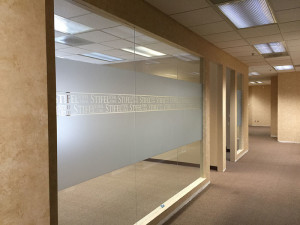When designing or renovating an interior, a lot of thought goes into the form of space and the degree of enclosure (the placement and quantity of windows and doorways). As organizations opt for flatter, more collaborative structures, the spaces they inhabit need to reflect these decisions as well. This is easily accomplished with an open floor plan with fewer walls–a layout that encourages more interaction among people. However, even in a flat organizational structure, there are times that require more privacy: meetings, phone calls, or simply creating distance from the outside world. In order to balance each building or office’s need for collaboration and privacy, you need to be able to customize the amount of privacy within each space.
How to Tailor the Amount of Privacy Within a Space

The amount of privacy within a space is directly correlated to the number of barriers created between one space and another. A solid wall feels private because its presence prevents light from filtering through, softens noise from the other side, and blocks your view of any movement or activity. To maintain an open space feeling while creating privacy, you need to allow some of these elements to pass through, while minimizing others. For this, we turn to glass. Glass is a physical barrier that will soften noise by blocking the flow of sound waves. However, glass is also transparent and therefore, allows light to flow into the next room and allows you to see movement on the opposite as if the glass wasn’t there.
You can further adjust the level of privacy by altering the glass surface. Altering the glass surface minimizes the clarity of what can be seen on the opposite side while maintaining the flow of light from room to room. You can physically manipulate the surface by etching, cutting, sandblasting, or using any number of other techniques, or you can layer another surface onto the glass that has slightly less transparency, such as an architectural film. The example below shows a die-cut pattern in an architectural film that was then applied to the glass surface.
Capture the Look of Cut or Texturized Glass for a Fraction of the Price
While etched, cut, sandblasted, or textured glass can effectively tailor the space’s level of privacy without causing it to feel confined, altered glass also may come with a hefty price tag. In addition, the effect is permanent, and so not always advisable, for example in a leased space. Therefore, physically altering a glass surface will not suit every project’s requirements. However, architectural film is an equally effective alternative for creating transparent privacy at a fraction of the cost. Decorative architectural films can be used on a variety of interior glass surfaces to enhance privacy while maintaining an open feel. Below are just some of environments where architectural films could be used in your next project:
- conference rooms
- lobbies
- retail environments
- residential settings
- private offices
- exterior windows
- partitions
- verandas
Customize Your Use of Architectural Films

How you implement architectural film into a space is only limited by your creativity (and ours!). With options like color, die-cutting, gradient films, and layering multiple films, you can create a solution that is both functional and aesthetic.
To learn how you could use custom architectural film in your next project, talk with one of our experts at Starfish Signs & Graphics.


